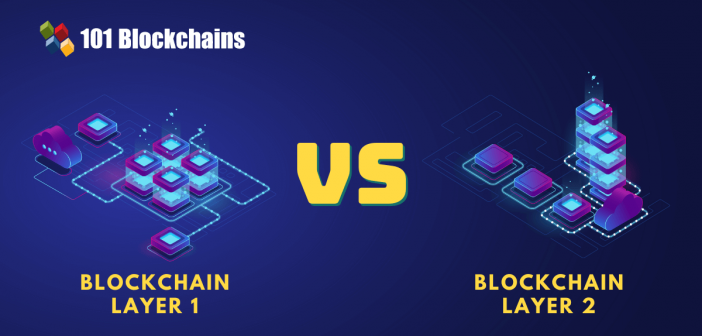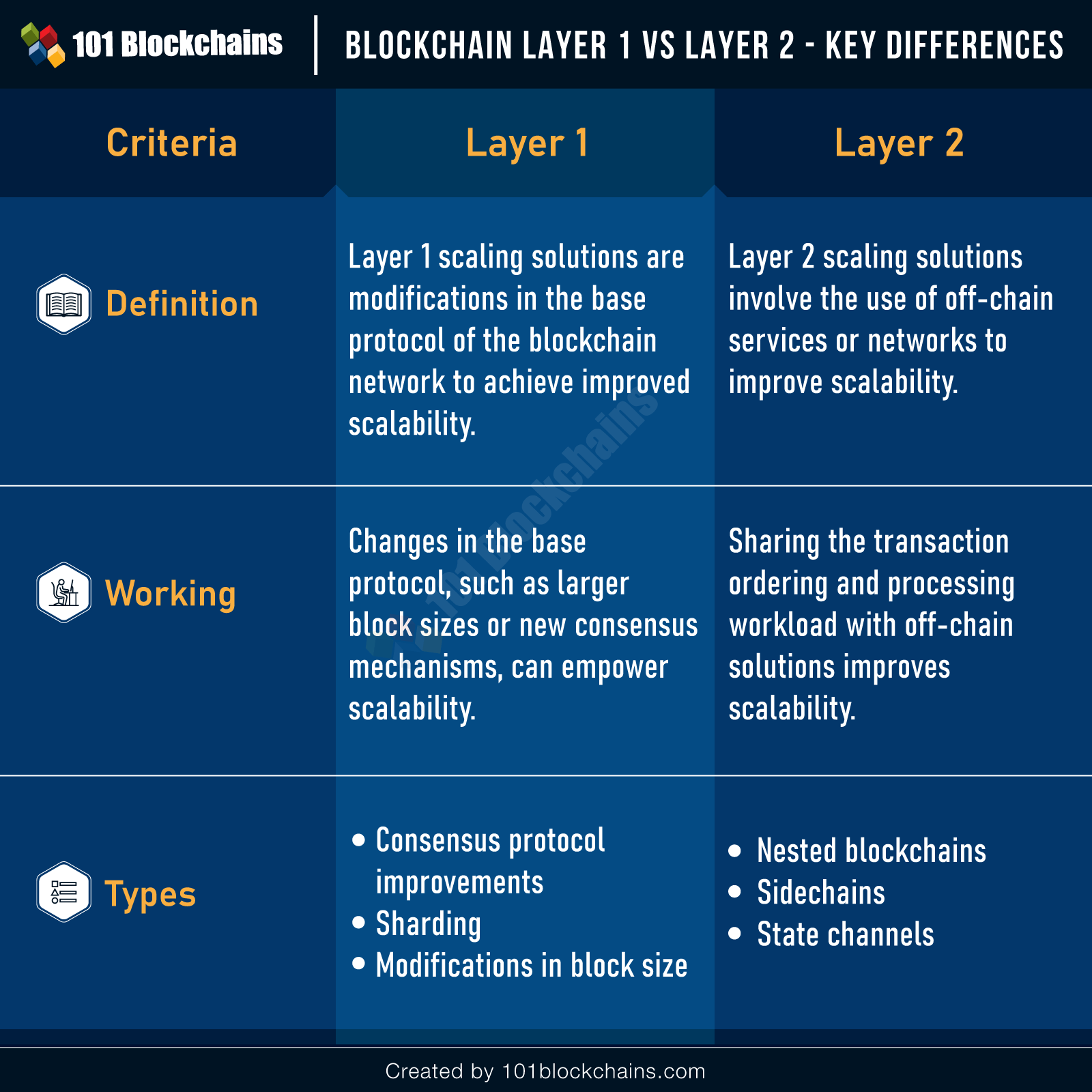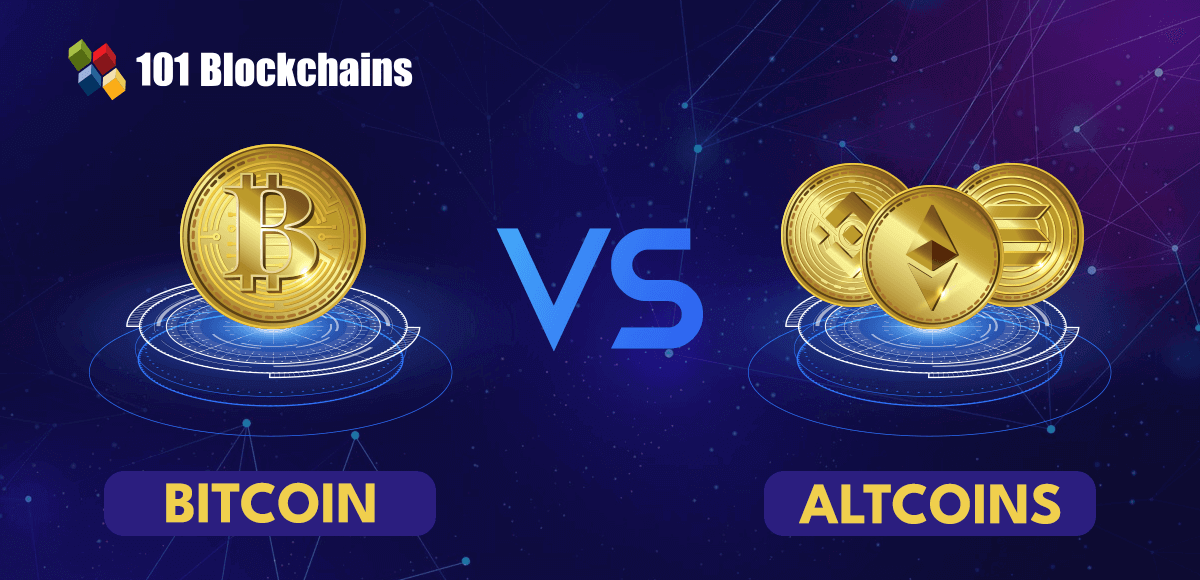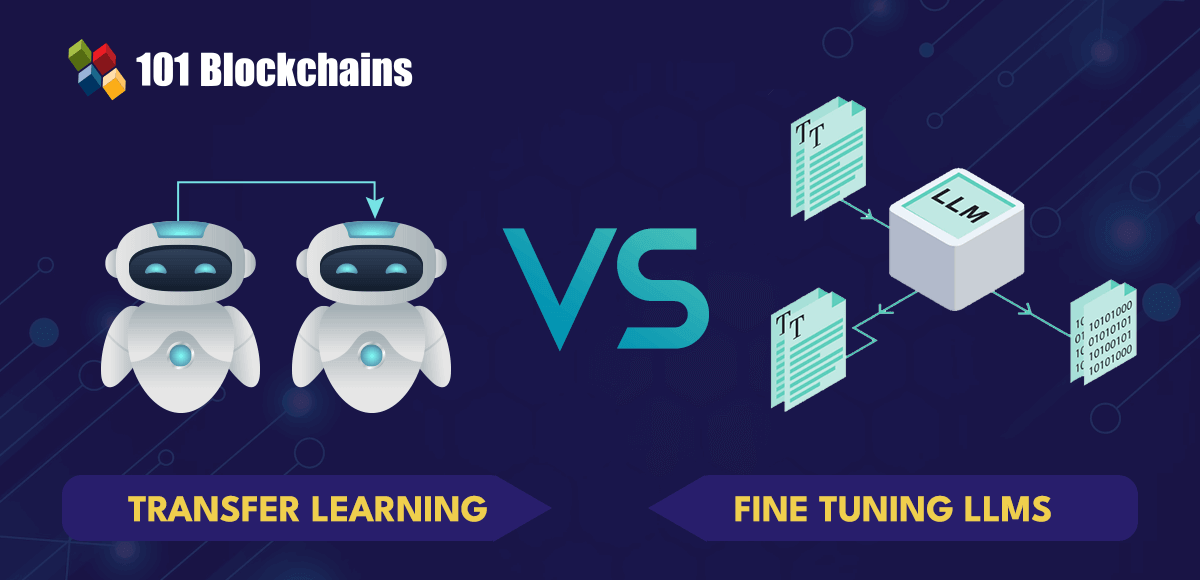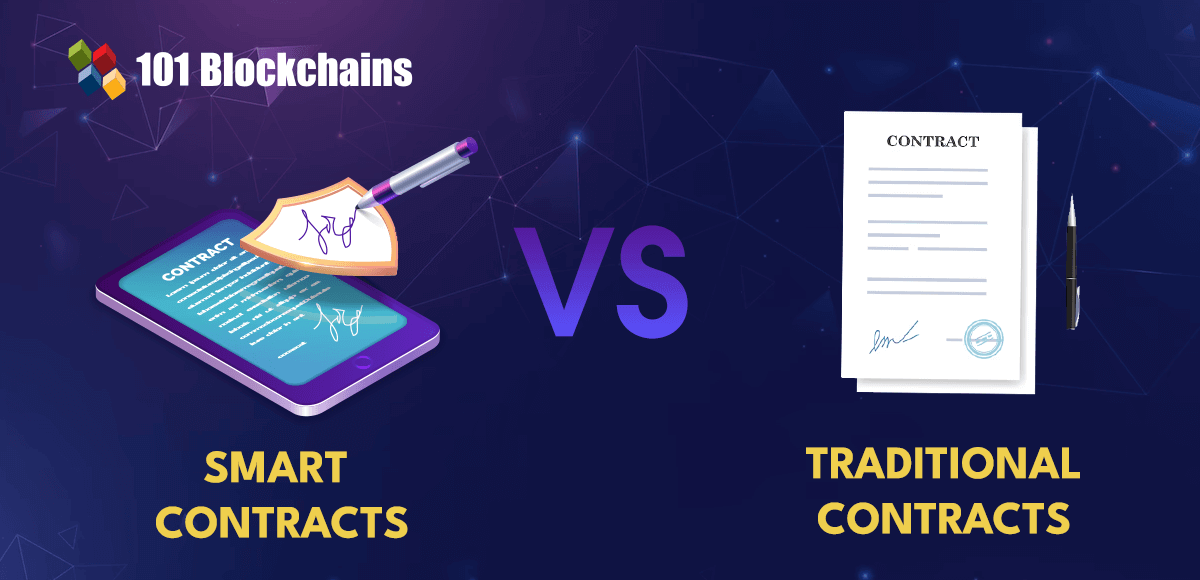The significance of scaling in the blockchain ecosystem slowly becomes more evident as blockchain adoption gains momentum. With the help of subtle improvements in the system throughput rate, blockchain networks can accommodate new applications and an increased volume of transactions. In the debates focused on blockchain scalability, the blockchain layer 1 vs layer 2 debate often garners unparalleled attention.
The growing large-scale use of cryptocurrencies in daily life has prompted the creation of blockchain layers for facilitating improved network security and recordkeeping, among other functionalities. Layer 1 basically refers to the base blockchain protocol, while layer 2 refers to a third-party solution integrated with layer 1 to facilitate scalability.
The following post helps you discover a detailed overview of the layer 1 vs layer 2 blockchain comparison. You can find an outline of the different types of solutions included in layer 1 and layer 2 blockchain. At the same time, you can notice the qualities associated with both types of scaling approaches.
Build your identity as a certified blockchain expert with 101 Blockchains’ Blockchain Certifications designed to provide enhanced career prospects.
Why Is Scalability Important?
Blockchain technology comes with many given benefits, such as improved security levels, better recordkeeping, and fuss-free transactions. However, scalability continues to be a serious concern, which generally leads to debate over “Is layer-1 or 2 better?” in discussions around new blockchain networks. Every blockchain network follows a decentralized system for completing transactions in different steps.
The different steps required for blockchain transactions often take up a lot of time and processing power. Now, imagine if a blockchain network is clogged up with transactions stacked up one after the other. In such cases, the application cannot fulfill the transaction requests of all users, thereby creating inequality in user experience. Therefore, you can clearly notice how scalability is an essential requirement for the future of blockchain networks.
Why Do Blockchain Networks Face Problems with Scalability?
Another important factor you should know before finding the difference between layer 1 and layer 2 scaling solutions is the root cause of the problem. Why do you have to face such an issue in the first place? The only answer for scalability issues in blockchain networks comes from the fact that blockchain networks are decentralized.
Blockchain networks use processing power and time for safeguarding user privacy and integrity of transactions. The data transactions must pass through different steps, including acceptance, mining, distribution, and verification on a node network. A blockchain network invests so much processing power and time in decentralization and security that it falls back in terms of scalability. This is where blockchain layers come into the picture.
Not sure how to build your career in enterprise blockchains? Enroll Now in How to Build Your Career in Blockchains Course
Layer 1 and Layer 2 Solutions
Layer 1 solutions basically involve changes in the base protocol of blockchain networks for ensuring better scalability. On the other hand, layer 2 solutions focus on adding third-party integrations to the mainnet of the blockchain network. While layer 1 solutions focus on modifying the base protocol, layer 2 solutions emphasize supporting the base protocol with off-chain solutions or protocols. While the basic distinction provides an answer to “What is the difference between layer 1 and layer 2 blockchain?” you must understand each term in detail. A comprehensive understanding of layer 1 and layer 2 blockchain scaling solutions could help you draw a better comparison.
-
Layer 1 Scaling Solutions
The outline of layer 1 vs layer 2 blockchain scaling differences would be incomplete without the definition of layer 1 blockchains. As the name implies, the layer 1 blockchain network refers to the base protocol of the blockchain network. Layer 1 scaling solutions help in improving the base layer of the blockchain protocol to facilitate improvements in scalability.
You can discover a wide range of methods tailored for direct improvements in the scalability of blockchain networks with layer 1 solutions. For example, layer 1 solutions can enable direct modifications in protocol rules for improving transaction capacity and speed. At the same time, the layer 1 scaling solutions can offer better scope for accommodating more data and users. The common approaches followed in layer 1 scaling include improvements in block size or speed of block creation.
However, the blockchain layer 1 vs layer 2 debate would take the two most important layer 1 scaling solutions into consideration. The two foundational modifications for achieving layer 1 scaling in blockchain networks include consensus protocol changes and sharding.
For example, some consensus mechanisms such as Proof of Stake could provide better efficiency in comparison to Proof of Work blockchain protocols. On the other hand, sharding helps in the distribution of the workload of the whole network among different datasets, known as shards.
Curious to learn about blockchain implementation and strategies? Enroll Now in Blockchain Technology – Implementation And Strategy Course!
-
Layer 2 Scaling Solutions
The next player in the difference between layer 1 and layer 2 blockchain, i.e., layer 2 scaling solutions, are unique technologies. The basic vision of layer 2 scaling focuses on using networks or technologies working over an underlying blockchain protocol. With the help of the off-chain protocol or network, a blockchain network could achieve improved scalability and efficiency.
Layer 2 scaling solutions basically involve transferring the transaction burden of a blockchain protocol to the off-chain architecture. The off-chain architecture would report the final results of the transferred transaction to the main blockchain. In simple words, layer 2 scaling solutions facilitate simpler and flexible delegation of data processing tasks to supporting architecture. As a result, the base blockchain protocol does not experience congestion, thereby opening up the doors to scalability.
One of the common examples of layer 2 scaling solutions refers to Lightning Network, which serves as a scaling solution for Bitcoin. The Lightning Network can help in improving transaction speeds and efficiency on the Bitcoin blockchain. In addition, you can also find many other solutions in support of layer 2 scaling in layer 1 vs layer 2 blockchain debates. The notable examples of layer 2 scaling solutions include nested blockchains, sidechains, and state channels.
What is the difference between Layer 1 and Layer 2 Blockchain Solutions?
Please include attribution to 101blockchains.com with this graphic. <a href='https://101blockchains.com/blockchain-infographics/'> <img src='https://101blockchains.com/wp-content/uploads/2022/03/Blockchain-Layer-1-vs-Layer-2-Key-Differences.png' alt='Blockchain Layer 1 vs Layer 2='0' /> </a>
The basic outline of layer 1 and layer 2 scaling solutions gives the right foundation to differentiate between them. Here are some of the notable points of difference between layer 1 and layer 2 blockchain scaling solutions.
-
Definition
Layer 1 scaling solutions basically refer to the modifications in the base layer of the blockchain protocol for desired improvements. For example, you can increase the block size for accommodating more transactions or change consensus protocols for speed and efficiency.
On the other side of the “Is Layer-1 or 2 better?” debate, layer 2 scaling solutions work as off-chain solutions sharing the load of the main blockchain protocol. The mainnet of a blockchain protocol transfers specific information processing and transaction processing tasks to layer 2 protocols, networks, or applications. The off-chain protocols or solutions complete the designated task and report the final results to the main blockchain layer.
-
Method of Working
The blockchain layer 1 vs layer 2 comparison would also take the basic method or approach of working into account. In the case of layer 1 blockchain networks, the basic method for scaling focuses on changing the base protocol itself. As a matter of fact, you have to make fundamental changes in blockchain protocols with layer 1 scaling solutions. So, you would not have any opportunity to downsize the modifications immediately if the transaction load drops radically.
On the contrary, layer 2 scaling solutions work as off-chain solutions, which operate independently of the main blockchain protocol. The off-chain protocols, networks, or solutions only report the final results demanded by the main blockchain protocol. In a way, layer 2 blockchain scaling solutions work by sharing the transaction load of the main blockchain network.
Curious to learn about blockchain implementation and strategies? Enroll Now in Blockchain Technology – Implementation And Strategy Course!
-
Types of Solutions
The next important criteria for finding answers to “What is the difference between layer 1 and layer 2 blockchain?” would refer to the types of solutions you can find. In the case of layer 1 blockchain solutions, you can find two prominent types of solutions such as consensus protocol improvement and sharding. Layer 1 scaling also includes changes to block size or block creation speed for ensuring desired functionalities.
In the case of blockchain layer 2 scaling solutions, there is practically no limit to the type of solutions you can use. Any protocol, network, or application can serve as an off-chain layer 2 solutions for blockchain networks. However, you need to take note of the popular layer 2 scaling solutions such as nested blockchains, sidechains, and state channels.
-
Qualities
You can also find a clear impression of the difference between layer 1 and layer 2 by focusing on the qualities of both types of networks. Layer 1 networks serve as the source of truth and bear the final responsibility for transaction settlement. You can find a native token on layer 1 networks for accessing the network’s resources. Another important trait in the case of layer 1 blockchain networks refers to innovation in the design of consensus mechanisms.
Layer 2 scaling solutions or networks offer the same functionalities as the layer 1 blockchains, albeit with additional traits. For example, layer 2 solutions improve the network performance alongside programmability while reducing transaction fees. Each layer 2 solution features a unique method for mapping transactions back to the concerned base layer.
-
Setbacks
The setbacks with layer 1 and layer 2 solutions don’t account for differences. On the contrary, they show the common highlights between the two types of scaling solutions. The only problem you can find common in blockchain layer 1 vs layer 2 solutions is the difficulty in adding the layers to existing protocols.
Start learning Blockchain with World’s first Blockchain Skill Paths with quality resources tailored by industry experts Now!
Final Words
The differences in the blockchain layer 1 vs layer 2 comparison show that both of them focus on improving scalability. Layer 1 scaling focuses on adjustments in the original blockchain protocol to enable scalability. On the other hand, layer 2 scaling involves the use of third-party solutions, networks, or protocols for expanding blockchain scalability. With the help of off-chain solutions sharing the blockchain network workload, scalability is easier to achieve.
However, when you look closely at both of them, they are distinct layers of improvement on a blockchain protocol. The continuously expanding blockchain ecosystem with new solutions like DeFi and NFTs has been drawing more users every day. Therefore, scaling is an imperative necessity for the sustainability of blockchain networks. Start learning more about blockchain scalability and its implications now.
*Disclaimer: The article should not be taken as, and is not intended to provide any investment advice. Claims made in this article do not constitute investment advice and should not be taken as such. 101 Blockchains shall not be responsible for any loss sustained by any person who relies on this article. Do your own research!

